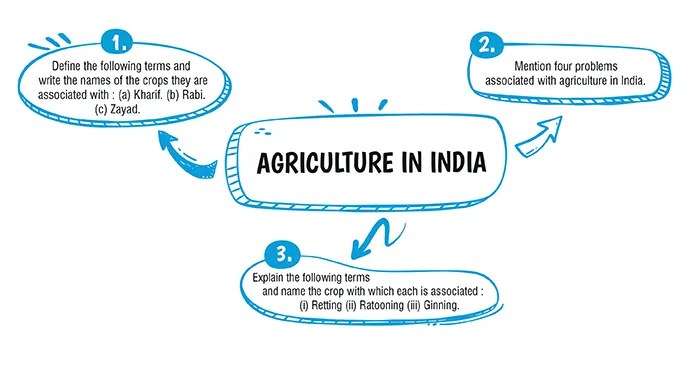Table of Contents

Ans. (d) all of these
Explanation:
Agriculture also provides a good market for the farm inputs like implements, fertilisers, pesticides, machinery, etc.
Ans. (c) Both (a) and (b)
Explanation:
The sowing of wheat seeds is done by using drilling or the broadcasting method. The seeds germinate in about three or four days. The temperature should be low during the growing season.
Explanation:
(a) Kharif is the crop season in which the ground is prepared in the months of April-May, seeds are sown in June, and harvesting is done in the beginning of November. Rice, Maize, Bajra and pulses are some of the crops grown in Kharif season.
(b) Rabi is the crop season in which the ground is prepared by the end of October or by the beginning of November and harvesting is done in the month of March. Wheat, Barley, Gram and Oilseeds are some of the crops grown in Rabi season.
(c) Zayad is the crop season of summer. Rice, Maize, Groundnut and Fruits are some of the crops that grow in Zayad season.
Explanation:
Problems of Indian agriculture are:
1. Uncertainty of rainfall.
2. Uneconomic size of holdings.
3. Illiteracy and ignorance.
4. Out-dated implements.
Explanation:
(i) Retting : It is associated with jute. It is a micro-biological process. It loosens the bark and facilitates removal of fibre from the stalk.
(ii) Ratooning : It is associated with sugarcane. After the first crop the sugarcane is cut leaving the root intact in the soil. The lower part of the stem which is left in the soil is well fertilised and the stem begins to grow again.
(iii) Ginning : It is associated with cotton. The cotton fibre is separated from the raw materials or the seeds.
Download Mind Map of this chapter
Download NowWant to Practice Mock Tests of this chapter
Practice NowDownload Important Questions of this chapter
Download Now| Chapter No. | Chapter Name |
|---|---|
| Chapter 1 | Map Study: Interpretation of Topographical Maps |
| Chapter 2 | Map of India |
| Chapter 3 | Location, Extent and Physical features |
| Chapter 4 | Climate of India |
| Chapter 5 | Soil Resources |
| Chapter 6 | Natural Vegetation of India |
| Chapter 7 | Water Resources |
| Chapter 8 | Mineral and Energy Resources |
| Chapter 9 | Agriculture In India |
| Chapter 10 | Industries in India: Agro Based |
| Chapter 11 | Industries in India: Mineral Based |
| Chapter 12 | Transport in India |
| Chapter 13 | Waste Generation and Management |
CBSE Important Questions Class 10
ICSE Important Questions Class 10
CBSE Important Questions Class 10
ICSE Important Questions Class 10